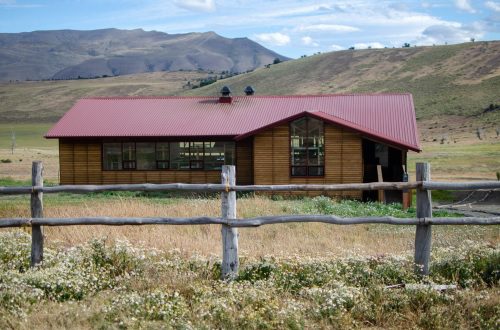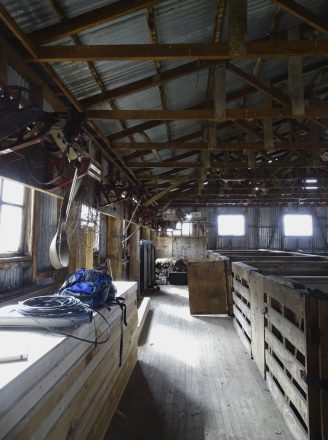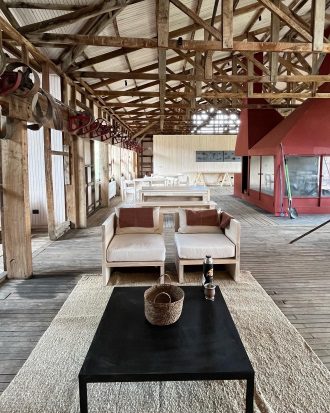The shearing shed: A cultural legacy
Though it tends to be associated only with Argentina, gaucho culture has permeated Chilean Patagonia since the early 20th century, when the first settlers arrived in the mountain town of Futaleufú, nestled amid forests 10 kilometers from the border.

There were different estates in the territory that were the epicenter of ranching and the engine of the regional economy. Their structure is very influenced by English architecture, composed of houses, stables, shearing sheds and extensive pastures where a vast variety of plant and animal species live.
They are gauchos’ homes, where along with their dogs, horses and sheep they live together with other people dedicated to livestock or agricultural tasks, such as blacksmithing, carpentry and even fishing.
The Explora Conservation Reserve in Torres del Paine is composed of 3 former estates, one of which is known as 2 de Enero, where vestiges of gaucho culture like the shearing shed can be found, which Explora decided to restore to highlight its importance to the area.
Explora Assistant Manager of Conservation Reserves Romina Da Pieve explained that restoration began in 2021 and took two years to complete. The idea was to rescue local cultural heritage without generating new impacts on the area and to create a space that will bring travelers closer to estate culture and in that way explain its operation and impact on the area to them.

The architects in charge of this project were Rodrigo Pedraza and Diego Aguiló, who sought to discover the entire territory in depth in its different seasons prior to the restoration. They were also in charge of building the stables and are currently building other facilities.
“The challenge was to design the recovery of a building full of centuries-old traditions. The shed’s first life cycle was marked by the shearing activities that gauchos engaged in for over half a century. The remodeling will bring new inhabitants together. Those Patagonian traditions will continue to be present; every beam of the original structure, each object recovered, each stopped machine will help to remind us that we are not the first to come to these faraway lands and that the life histories of those who came before us must nourish us to imagine a better future. This is the value of recovering heritage; it is a place that invites us to celebrate a valuable past, from which a better and more sustainable world can be built,” the architect said.

Romina Da Pieve commented that some of the elements that were conserved, and which visitors will be able to see, are the lenga flooring, the shearing machines, engine, baling press, a number of tools, and the table where the wool was placed, turning this place into a veritable museum.
It is currently used as an exclusive dining room for travelers staying at Explora in Torres del Paine. The space has a living room, toilets and a kitchen, ideal for a break during a day of exploration.
The life of gauchos
Gauchos are known for sharing the habit of drinking bitter mate and preparing the famous lamb barbecued over an open fire. They engage in different tasks on the estate, such as shepherds, herders, shearers and tamers.
Herding tasks consist of moving the piños or herds of animals from one estate to another through a rugged territory and the harsh pampa climate.
Horse taming is one of the fiercest tasks they perform, and they are experts at displaying their courage and gallantry with the horses.

Gauchos are excellent riders, lovers of the countryside and very attached to their traditions. They are the children of the vastness of the Argentine, Uruguayan and Chilean pampas since colonial times.
Shearing festival
When the summer approaches, between September and January, the wool that the sheep have grown over the course of a year is cut. The “harvest” is a long-awaited date in the region and gives rise to intense work by all the estate’s staff, with external workers often brought in, and it tends to be accompanied by celebrations and barbecues.
Equipped with scissors or a machine, each gaucho removes the wool fleece from the sheep and once ready they are collected in a small corral where they are counted: the more sheep sheared, the higher the pay.
The fleeces collected are then “thrown” onto a selection table with the cut part down to allow cleaning, after which they are folded and rolled up for pressing and baling.
Caroline Van Kilsdonk, head of the Torres del Paine Conservation Reserve, commented that there are few places where the shearing shed dynamic existed, as it was a space that brought livestock work and friendship together amid its walls and gear. “The roads and the tools have improved over time, but the mystique of shearing is still alive in the troupes that get together every year to work together and weave the threads of their customs again alongside the barbecue and accompanied by mate and milongas.”

